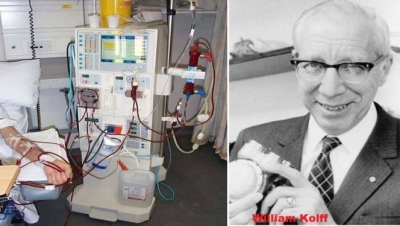
Kidney failure can lead to death if untreated and is an illness that is as old as humanity itself. In 1924, a German doctor named Georg Haas carried out the first dialysis treatment on a human. However, this treatment was ineffective and the patient did not survive.
It was a Dutch doctor, Willem Kolff, who conducted the first successful dialysis treatment of a 67-year old patient. The patient was discharged with normal kidney function after a week.
Kolff used a rotating drum kidney or artificial kidney to filter uremic toxins from the body. His model improved on the earlier one made by Haas by using membranous tubes made from cellophane. Kolff began work on his artificial kidney in the late 1930’s after watching a young man die of kidney failure. Kolff decided that he would make a machine that would do the work of the kidneys.
Over the years, Kolff improvised – using sausage skins, orange juice cans, a washing machine and other common items to make a device that could clear the blood of toxins. He created the first successful artificial kidney in 1945. One of the drawbacks to Kolff’s machine was that while the Kolff kidney effectively removed toxins from the blood, it was unable to remove excess fluid from the patient’s blood.
Today dialysis machines are designed to filter out excess fluid as well as toxins and are highly sophisticated. However, Kolff’s machine is considered the first modern drum dialyzer and it remained the standard over the next decade.
Picture Credit : Google




